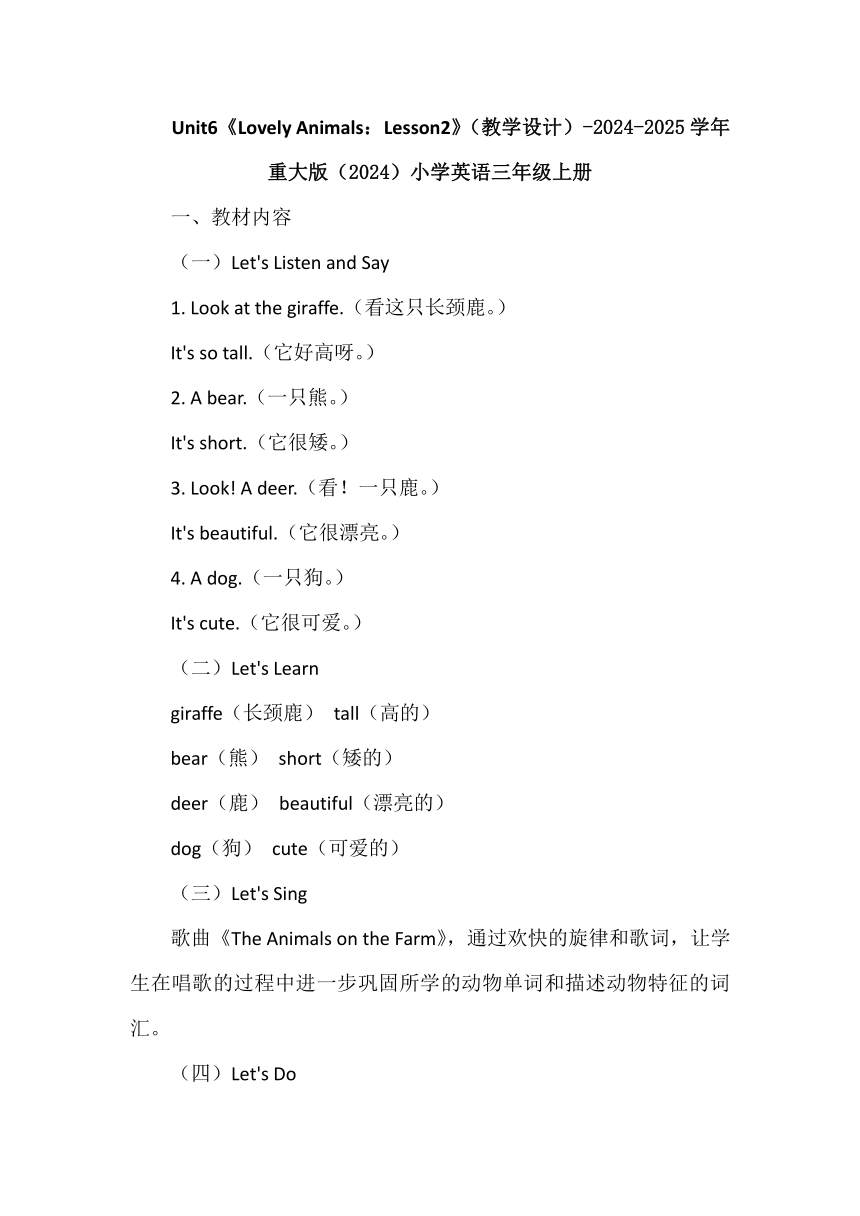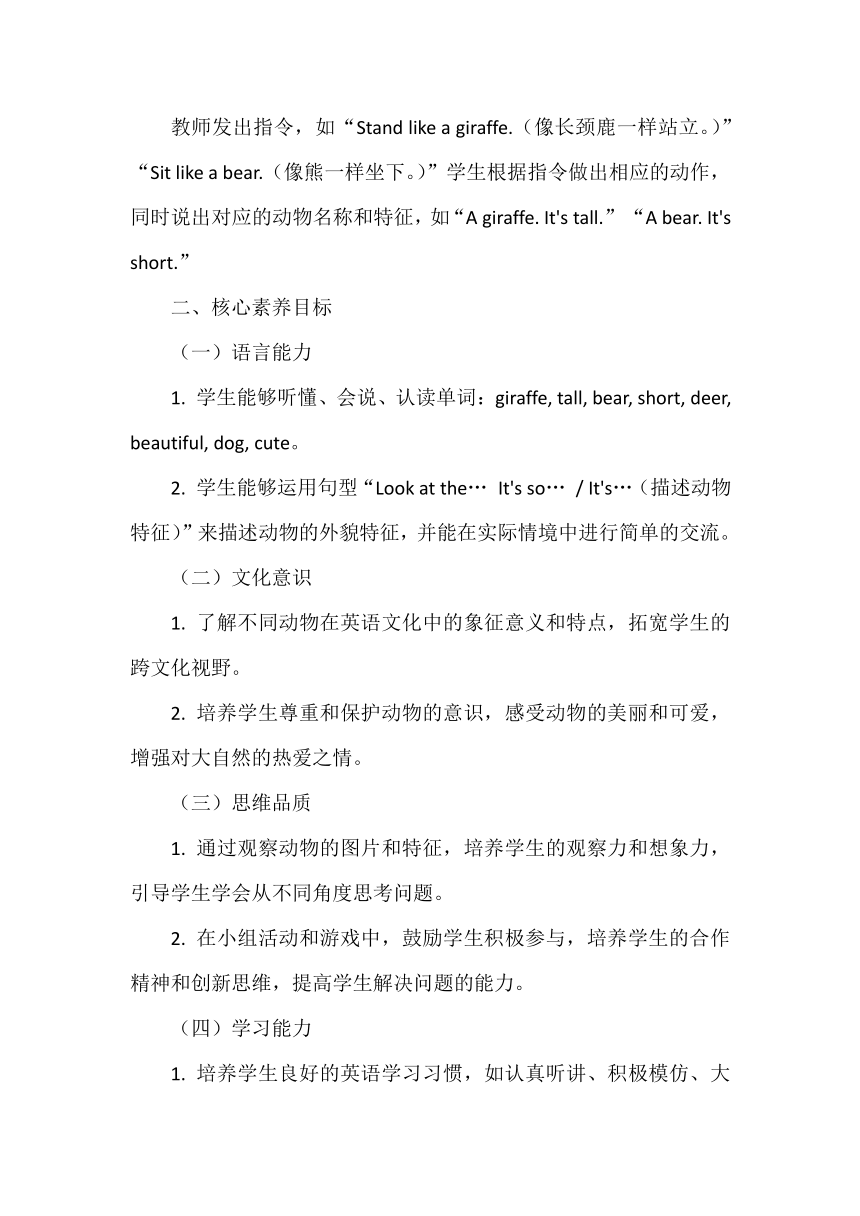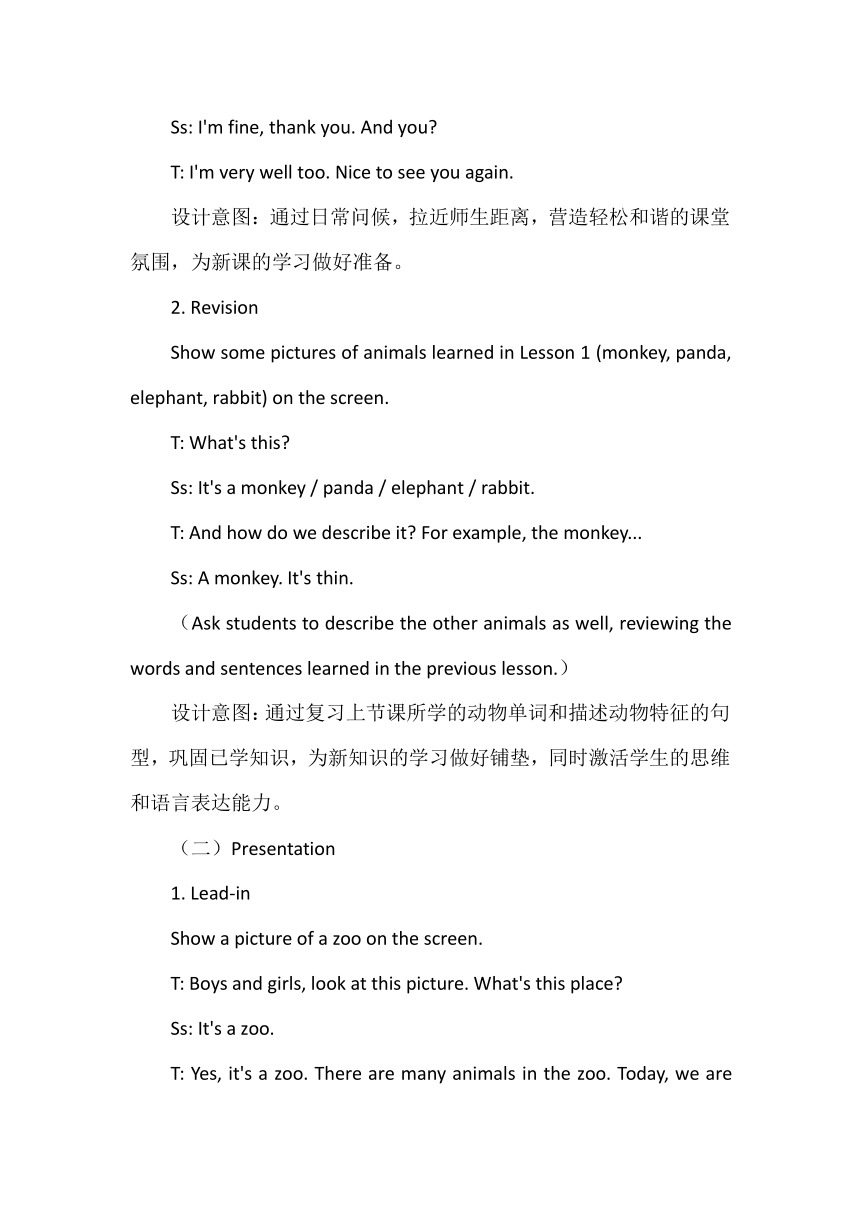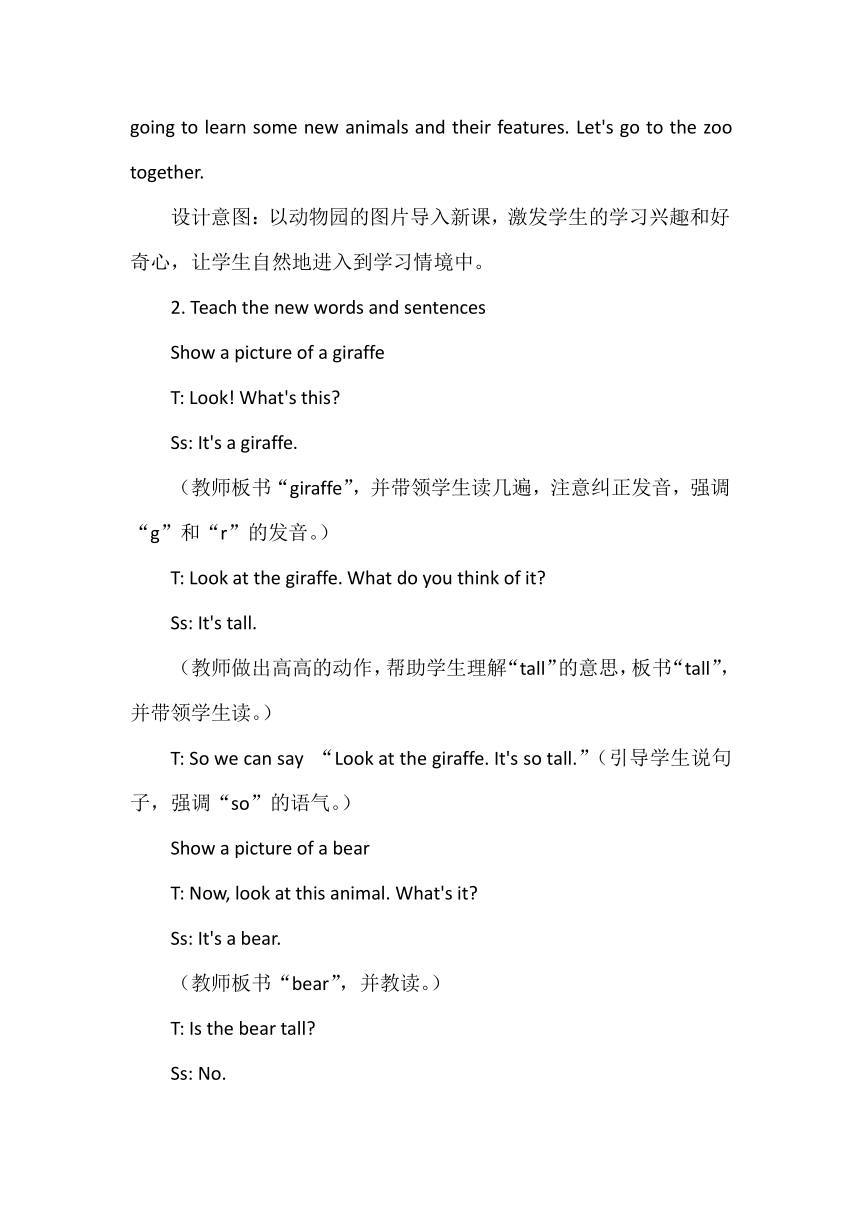Unit6 Lovely Animals Lesson 2 教案
文档属性
| 名称 | Unit6 Lovely Animals Lesson 2 教案 |  | |
| 格式 | docx | ||
| 文件大小 | 24.8KB | ||
| 资源类型 | 教案 | ||
| 版本资源 | 重庆大学版 | ||
| 科目 | 英语 | ||
| 更新时间 | 2024-10-30 16:51:23 | ||
图片预览





文档简介
Unit6《Lovely Animals:Lesson2》(教学设计)-2024-2025学年重大版(2024)小学英语三年级上册
一、教材内容
(一)Let's Listen and Say
1. Look at the giraffe.(看这只长颈鹿。)
It's so tall.(它好高呀。)
2. A bear.(一只熊。)
It's short.(它很矮。)
3. Look! A deer.(看!一只鹿。)
It's beautiful.(它很漂亮。)
4. A dog.(一只狗。)
It's cute.(它很可爱。)
(二)Let's Learn
giraffe(长颈鹿) tall(高的)
bear(熊) short(矮的)
deer(鹿) beautiful(漂亮的)
dog(狗) cute(可爱的)
(三)Let's Sing
歌曲《The Animals on the Farm》,通过欢快的旋律和歌词,让学生在唱歌的过程中进一步巩固所学的动物单词和描述动物特征的词汇。
(四)Let's Do
教师发出指令,如“Stand like a giraffe.(像长颈鹿一样站立。)”“Sit like a bear.(像熊一样坐下。)”学生根据指令做出相应的动作,同时说出对应的动物名称和特征,如“A giraffe. It's tall.” “A bear. It's short.”
二、核心素养目标
(一)语言能力
1. 学生能够听懂、会说、认读单词:giraffe, tall, bear, short, deer, beautiful, dog, cute。
2. 学生能够运用句型“Look at the… It's so… / It's…(描述动物特征)”来描述动物的外貌特征,并能在实际情境中进行简单的交流。
(二)文化意识
1. 了解不同动物在英语文化中的象征意义和特点,拓宽学生的跨文化视野。
2. 培养学生尊重和保护动物的意识,感受动物的美丽和可爱,增强对大自然的热爱之情。
(三)思维品质
1. 通过观察动物的图片和特征,培养学生的观察力和想象力,引导学生学会从不同角度思考问题。
2. 在小组活动和游戏中,鼓励学生积极参与,培养学生的合作精神和创新思维,提高学生解决问题的能力。
(四)学习能力
1. 培养学生良好的英语学习习惯,如认真听讲、积极模仿、大胆开口说英语等。
2. 激发学生学习英语的兴趣,让学生在轻松愉快的氛围中学习,提高学生的自主学习能力和学习积极性。
三、教学重难点
(一)教学重点
1. 掌握单词:giraffe, tall, bear, short, deer, beautiful, dog, cute的发音和拼写。
2. 理解并运用句型“Look at the… It's so… / It's…(描述动物特征)”来描述动物的外貌特征。
(二)教学难点
1. 单词“giraffe”的发音,以及“tall”和“short”、“beautiful”和“cute”的准确理解和运用。
2. 引导学生在实际情境中灵活运用所学的单词和句型进行交流,培养学生的语言综合运用能力。
四、教学准备
1. 教材配套的教学课件、单词卡片、动物图片、头饰。
2. 多媒体设备。
3. 奖励学生的小贴纸、小奖品等。
五、教学过程
(一)Warming-up
1. Greetings
T: Hello, boys and girls. How are you today
Ss: I'm fine, thank you. And you
T: I'm very well too. Nice to see you again.
设计意图:通过日常问候,拉近师生距离,营造轻松和谐的课堂氛围,为新课的学习做好准备。
2. Revision
Show some pictures of animals learned in Lesson 1 (monkey, panda, elephant, rabbit) on the screen.
T: What's this
Ss: It's a monkey / panda / elephant / rabbit.
T: And how do we describe it For example, the monkey...
Ss: A monkey. It's thin.
(Ask students to describe the other animals as well, reviewing the words and sentences learned in the previous lesson.)
设计意图:通过复习上节课所学的动物单词和描述动物特征的句型,巩固已学知识,为新知识的学习做好铺垫,同时激活学生的思维和语言表达能力。
(二)Presentation
1. Lead-in
Show a picture of a zoo on the screen.
T: Boys and girls, look at this picture. What's this place
Ss: It's a zoo.
T: Yes, it's a zoo. There are many animals in the zoo. Today, we are going to learn some new animals and their features. Let's go to the zoo together.
设计意图:以动物园的图片导入新课,激发学生的学习兴趣和好奇心,让学生自然地进入到学习情境中。
2. Teach the new words and sentences
Show a picture of a giraffe
T: Look! What's this
Ss: It's a giraffe.
(教师板书“giraffe”,并带领学生读几遍,注意纠正发音,强调“g”和“r”的发音。)
T: Look at the giraffe. What do you think of it
Ss: It's tall.
(教师做出高高的动作,帮助学生理解“tall”的意思,板书“tall”,并带领学生读。)
T: So we can say “Look at the giraffe. It's so tall.”(引导学生说句子,强调“so”的语气。)
Show a picture of a bear
T: Now, look at this animal. What's it
Ss: It's a bear.
(教师板书“bear”,并教读。)
T: Is the bear tall
Ss: No.
T: Right. It's short.(教师做出矮的动作,板书“short”,教读单词。)
T: We can say “A bear. It's short.”(让学生模仿说句子。)
Show a picture of a deer
T: What's this
Ss: It's a deer.
(教师板书“deer”,并教读。)
T: Look at the deer. How is it
Ss: It's beautiful.
(教师用欣赏的表情和语气说“beautiful”,板书“beautiful”,教读单词,让学生感受单词的含义。)
T: So we can say “Look! A deer. It's beautiful.”(引导学生说句子。)
Show a picture of a dog
T: And this is...
Ss: A dog.
(教师板书“dog”,并教读。)
T: The dog is very...
Ss: Cute.
(教师做出可爱的动作,板书“cute”,教读单词。)
T: We can say “A dog. It's cute.”(引导学生说句子。)
设计意图:通过展示动物图片,直观地教授新单词和句型,让学生在真实的情境中学习,加深对单词和句型的理解和记忆。同时,运用动作、表情等方式帮助学生理解单词的含义,增加学习的趣味性。
(三)Practice
1. Listen and repeat
T: Now, let's listen to the tape and repeat. Pay attention to the pronunciation and intonation.
(播放课文录音,学生跟读,注意模仿语音、语调。教师可以适时地暂停录音,让学生重复个别单词或句子,加强训练。)
设计意图:让学生跟读录音,有助于纠正发音,培养良好的语感,同时进一步熟悉单词和句子的发音和用法。
2. Group work
Divide the students into groups of four.
T: Now, in your groups, take turns to point to the pictures of animals on the screen and describe their features using the sentences we learned. For example, one student says “Look at the giraffe. It's so tall.” and the other students listen and repeat. Then change the roles.
(学生分组练习,教师巡视各小组,倾听学生的练习情况,及时给予指导和帮助。鼓励学生大胆开口说英语,并且注意单词的发音和句子的完整性。)
设计意图:通过小组活动,让学生在合作中练习口语表达,提高运用语言的能力,同时培养学生的团队合作精神和交流能力。每个学生都有机会参与到练习中,增强学生的学习自信心和积极性。
3. Game: Magic Box
Prepare a box with some pictures of animals inside (giraffe, bear, deer, dog).
T: Now, let's play a game called “Magic Box”. I'll pick a picture from the box without looking. You guess what animal it is by asking me questions. You can ask questions like “Is it tall / Is it cute / Is it a bear ” and I'll answer “Yes” or “No”. Then you try to guess the animal. The first group to guess correctly gets a point.
(For example, a student asks “Is it tall ” If the picture is of a giraffe, the teacher answers “Yes”. Then the students continue to ask questions until they guess the correct animal.)
设计意图:通过游戏的方式,激发学生的学习兴趣,巩固所学的单词和句型。同时,这个游戏可以培养学生的观察力、思维能力和语言运用能力,让学生在轻松愉快的氛围中学习英语。
(四)Production
1. Let's Sing
Play the song “The Animals on the Farm” on the multimedia.
T: Now, let's listen to a song about animals. Listen carefully and try to follow the lyrics.
(Play the song twice. The first time, let the students just listen and enjoy the melody. The second time, encourage the students to sing along with the music.)
After singing the song, ask the students some questions about the animals in the song.
T: What animals did you see in the song
Ss: There are cows, pigs, ducks, etc.
T: How are the cows described in the song
Ss: The cows are big.
(Ask similar questions about other animals in the song to review the words and sentences learned in this lesson and the previous one.)
设计意图:通过唱英语歌曲,不仅可以活跃课堂气氛,还能让学生在轻松愉快的氛围中进一步巩固所学的动物单词和描述动物特征的词汇。同时,提问环节可以检查学生对歌曲内容的理解和对知识的掌握情况,培养学生的听力和口语表达能力。
2. Let's Do
Explain the rules of the game “Let's Do” to the students.
T: Now, we are going to play another game “Let's Do”. I'll say some instructions like “Stand like a giraffe. / Sit like a bear.” You need to do the actions according to my instructions and say the corresponding animal name and its feature. For example, when I say “Stand like a giraffe.” you stand up straight and say “A giraffe. It's tall.” Are you ready
Start the game. Give different instructions one by one and let the students do the actions and say the words.
(For example, “Jump like a rabbit.(像兔子一样跳。)” “Walk like an elephant.(像大象一样走。)” “Sleep like a dog.(像狗一样睡觉。)” etc.)
Encourage the students to be creative and come up with their own instructions and ask their classmates to do the actions.
设计意图:这个活动可以让学生将所学的知识与身体动作相结合,通过亲身体验来加深对单词和句型的理解和记忆。同时,培养学生的听力理解能力和快速反应能力,激发学生的学习兴趣和参与度。让学生自己创编指令,还可以培养学生的创新思维和语言运用能力。
(五)Summary
1. Review the words and sentences
T: Today, we learned some new animals and their features. Let's review them together. What are the new animals we learned
Ss: Giraffe, bear, deer, dog.
T: And how do we describe them
Ss: Look at the giraffe. It's so tall. / A bear. It's short. / Look! A deer. It's beautiful. / A dog. It's cute.
(Write the words and sentences on the blackboard again to reinforce the students' memory.)
设计意图:通过回顾本节课所学的单词和句型,帮助学生巩固知识,明确学习重点,加深记忆。同时,板书的再次呈现可以让学生更加清晰地看到所学内容,便于学生复习和总结。
2. Emotional Education
Show some pictures of animals in their natural habitats and some pictures of animals being hurt or in danger.
T: Boys and girls, animals are our friends. They are very lovely and important in our lives. We should protect them and their habitats. Look at these pictures. Some animals are suffering because of human activities. What can we do to help them
Ss: We can stop cutting down trees. / We can't hunt animals. / We can protect their homes. etc.
(Encourage the students to express their ideas and opinions about protecting animals.)
T: You are all very right. We should love and protect animals. Let's promise to be kind to animals and do our best to protect them.
设计意图:在总结知识的同时,对学生进行情感教育,培养学生热爱动物、保护动物的意识,让学生明白保护动物的重要性和紧迫性。通过展示不同的图片,引发学生的思考和情感共鸣,激发学生的责任感和使命感,培养学生的人文关怀精神。
(六)Homework
1. Listen to the tape and read the text for at least 3 times. Try to imitate the pronunciation and intonation.
2. Draw a picture of your favorite animal and write a short passage to describe its features using the words and sentences we learned in this lesson. For example, “My favorite animal is a cat. It's very cute. It has short legs and a long tail.”
设计意图:通过布置听读作业,让学生进一步巩固所学的单词和句子,培养学生的语感和口语表达能力。绘画写作作业可以激发学生的学习兴趣,发挥学生的想象力和创造力,同时让学生将所学知识运用到实际中,提高学生的语言综合运用能力。
六、作业布置
1.基础作业
听录音跟读课文5遍,模仿语音语调,家长签字。
抄写单词:giraffe, tall, bear, short, deer, beautiful, dog, cute,每个单词抄写3遍,边写边读,注意书写规范。
设计意图:通过听读和抄写作业,巩固学生对单词和课文的记忆,培养学生的听说读写能力,同时让家长参与到学生的学习过程中,起到监督和促进作用。
2.拓展作业
制作一张动物卡片,在卡片上画出自己喜欢的动物,并用英文写上它的名字和特征。例如:“A panda. It's fat and cute. It has black and white fur.”然后在班级内展示自己的作品,并用英语向同学们介绍自己制作的动物卡片。
和家长一起玩“猜动物”的游戏。家长用英语描述一种动物的特征,学生猜出动物的名称。然后学生和家长交换角色进行游戏。
设计意图:制作动物卡片可以培养学生的动手能力和创造力,同时让学生在制作过程中更加深入地了解动物的特征,巩固所学知识。玩游戏可以增加学习的趣味性,提高学生的口语表达能力和与家长的互动交流能力,营造良好的家庭学习氛围。
3.实践作业
利用周末时间去动物园或公园观察动物,用所学的英语单词和句子描述你看到的动物的特征。可以记录下来,回学校后和同学们分享你的观察结果。
查阅资料,了解一种濒危动物的相关信息,包括它的名称、外貌特征、生活习性以及濒危原因等。用英文制作一张手抄报,下周一在班级内展示。
设计意图:通过实践活动,让学生将课堂所学知识运用到实际生活中,提高学生的语言运用能力和观察能力,同时培养学生对动物的关爱和保护意识。制作手抄报可以锻炼学生的信息收集和整理能力,以及绘画和书写能力,拓展学生的知识面,增强学生的环保意识和社会责任感。
一、教材内容
(一)Let's Listen and Say
1. Look at the giraffe.(看这只长颈鹿。)
It's so tall.(它好高呀。)
2. A bear.(一只熊。)
It's short.(它很矮。)
3. Look! A deer.(看!一只鹿。)
It's beautiful.(它很漂亮。)
4. A dog.(一只狗。)
It's cute.(它很可爱。)
(二)Let's Learn
giraffe(长颈鹿) tall(高的)
bear(熊) short(矮的)
deer(鹿) beautiful(漂亮的)
dog(狗) cute(可爱的)
(三)Let's Sing
歌曲《The Animals on the Farm》,通过欢快的旋律和歌词,让学生在唱歌的过程中进一步巩固所学的动物单词和描述动物特征的词汇。
(四)Let's Do
教师发出指令,如“Stand like a giraffe.(像长颈鹿一样站立。)”“Sit like a bear.(像熊一样坐下。)”学生根据指令做出相应的动作,同时说出对应的动物名称和特征,如“A giraffe. It's tall.” “A bear. It's short.”
二、核心素养目标
(一)语言能力
1. 学生能够听懂、会说、认读单词:giraffe, tall, bear, short, deer, beautiful, dog, cute。
2. 学生能够运用句型“Look at the… It's so… / It's…(描述动物特征)”来描述动物的外貌特征,并能在实际情境中进行简单的交流。
(二)文化意识
1. 了解不同动物在英语文化中的象征意义和特点,拓宽学生的跨文化视野。
2. 培养学生尊重和保护动物的意识,感受动物的美丽和可爱,增强对大自然的热爱之情。
(三)思维品质
1. 通过观察动物的图片和特征,培养学生的观察力和想象力,引导学生学会从不同角度思考问题。
2. 在小组活动和游戏中,鼓励学生积极参与,培养学生的合作精神和创新思维,提高学生解决问题的能力。
(四)学习能力
1. 培养学生良好的英语学习习惯,如认真听讲、积极模仿、大胆开口说英语等。
2. 激发学生学习英语的兴趣,让学生在轻松愉快的氛围中学习,提高学生的自主学习能力和学习积极性。
三、教学重难点
(一)教学重点
1. 掌握单词:giraffe, tall, bear, short, deer, beautiful, dog, cute的发音和拼写。
2. 理解并运用句型“Look at the… It's so… / It's…(描述动物特征)”来描述动物的外貌特征。
(二)教学难点
1. 单词“giraffe”的发音,以及“tall”和“short”、“beautiful”和“cute”的准确理解和运用。
2. 引导学生在实际情境中灵活运用所学的单词和句型进行交流,培养学生的语言综合运用能力。
四、教学准备
1. 教材配套的教学课件、单词卡片、动物图片、头饰。
2. 多媒体设备。
3. 奖励学生的小贴纸、小奖品等。
五、教学过程
(一)Warming-up
1. Greetings
T: Hello, boys and girls. How are you today
Ss: I'm fine, thank you. And you
T: I'm very well too. Nice to see you again.
设计意图:通过日常问候,拉近师生距离,营造轻松和谐的课堂氛围,为新课的学习做好准备。
2. Revision
Show some pictures of animals learned in Lesson 1 (monkey, panda, elephant, rabbit) on the screen.
T: What's this
Ss: It's a monkey / panda / elephant / rabbit.
T: And how do we describe it For example, the monkey...
Ss: A monkey. It's thin.
(Ask students to describe the other animals as well, reviewing the words and sentences learned in the previous lesson.)
设计意图:通过复习上节课所学的动物单词和描述动物特征的句型,巩固已学知识,为新知识的学习做好铺垫,同时激活学生的思维和语言表达能力。
(二)Presentation
1. Lead-in
Show a picture of a zoo on the screen.
T: Boys and girls, look at this picture. What's this place
Ss: It's a zoo.
T: Yes, it's a zoo. There are many animals in the zoo. Today, we are going to learn some new animals and their features. Let's go to the zoo together.
设计意图:以动物园的图片导入新课,激发学生的学习兴趣和好奇心,让学生自然地进入到学习情境中。
2. Teach the new words and sentences
Show a picture of a giraffe
T: Look! What's this
Ss: It's a giraffe.
(教师板书“giraffe”,并带领学生读几遍,注意纠正发音,强调“g”和“r”的发音。)
T: Look at the giraffe. What do you think of it
Ss: It's tall.
(教师做出高高的动作,帮助学生理解“tall”的意思,板书“tall”,并带领学生读。)
T: So we can say “Look at the giraffe. It's so tall.”(引导学生说句子,强调“so”的语气。)
Show a picture of a bear
T: Now, look at this animal. What's it
Ss: It's a bear.
(教师板书“bear”,并教读。)
T: Is the bear tall
Ss: No.
T: Right. It's short.(教师做出矮的动作,板书“short”,教读单词。)
T: We can say “A bear. It's short.”(让学生模仿说句子。)
Show a picture of a deer
T: What's this
Ss: It's a deer.
(教师板书“deer”,并教读。)
T: Look at the deer. How is it
Ss: It's beautiful.
(教师用欣赏的表情和语气说“beautiful”,板书“beautiful”,教读单词,让学生感受单词的含义。)
T: So we can say “Look! A deer. It's beautiful.”(引导学生说句子。)
Show a picture of a dog
T: And this is...
Ss: A dog.
(教师板书“dog”,并教读。)
T: The dog is very...
Ss: Cute.
(教师做出可爱的动作,板书“cute”,教读单词。)
T: We can say “A dog. It's cute.”(引导学生说句子。)
设计意图:通过展示动物图片,直观地教授新单词和句型,让学生在真实的情境中学习,加深对单词和句型的理解和记忆。同时,运用动作、表情等方式帮助学生理解单词的含义,增加学习的趣味性。
(三)Practice
1. Listen and repeat
T: Now, let's listen to the tape and repeat. Pay attention to the pronunciation and intonation.
(播放课文录音,学生跟读,注意模仿语音、语调。教师可以适时地暂停录音,让学生重复个别单词或句子,加强训练。)
设计意图:让学生跟读录音,有助于纠正发音,培养良好的语感,同时进一步熟悉单词和句子的发音和用法。
2. Group work
Divide the students into groups of four.
T: Now, in your groups, take turns to point to the pictures of animals on the screen and describe their features using the sentences we learned. For example, one student says “Look at the giraffe. It's so tall.” and the other students listen and repeat. Then change the roles.
(学生分组练习,教师巡视各小组,倾听学生的练习情况,及时给予指导和帮助。鼓励学生大胆开口说英语,并且注意单词的发音和句子的完整性。)
设计意图:通过小组活动,让学生在合作中练习口语表达,提高运用语言的能力,同时培养学生的团队合作精神和交流能力。每个学生都有机会参与到练习中,增强学生的学习自信心和积极性。
3. Game: Magic Box
Prepare a box with some pictures of animals inside (giraffe, bear, deer, dog).
T: Now, let's play a game called “Magic Box”. I'll pick a picture from the box without looking. You guess what animal it is by asking me questions. You can ask questions like “Is it tall / Is it cute / Is it a bear ” and I'll answer “Yes” or “No”. Then you try to guess the animal. The first group to guess correctly gets a point.
(For example, a student asks “Is it tall ” If the picture is of a giraffe, the teacher answers “Yes”. Then the students continue to ask questions until they guess the correct animal.)
设计意图:通过游戏的方式,激发学生的学习兴趣,巩固所学的单词和句型。同时,这个游戏可以培养学生的观察力、思维能力和语言运用能力,让学生在轻松愉快的氛围中学习英语。
(四)Production
1. Let's Sing
Play the song “The Animals on the Farm” on the multimedia.
T: Now, let's listen to a song about animals. Listen carefully and try to follow the lyrics.
(Play the song twice. The first time, let the students just listen and enjoy the melody. The second time, encourage the students to sing along with the music.)
After singing the song, ask the students some questions about the animals in the song.
T: What animals did you see in the song
Ss: There are cows, pigs, ducks, etc.
T: How are the cows described in the song
Ss: The cows are big.
(Ask similar questions about other animals in the song to review the words and sentences learned in this lesson and the previous one.)
设计意图:通过唱英语歌曲,不仅可以活跃课堂气氛,还能让学生在轻松愉快的氛围中进一步巩固所学的动物单词和描述动物特征的词汇。同时,提问环节可以检查学生对歌曲内容的理解和对知识的掌握情况,培养学生的听力和口语表达能力。
2. Let's Do
Explain the rules of the game “Let's Do” to the students.
T: Now, we are going to play another game “Let's Do”. I'll say some instructions like “Stand like a giraffe. / Sit like a bear.” You need to do the actions according to my instructions and say the corresponding animal name and its feature. For example, when I say “Stand like a giraffe.” you stand up straight and say “A giraffe. It's tall.” Are you ready
Start the game. Give different instructions one by one and let the students do the actions and say the words.
(For example, “Jump like a rabbit.(像兔子一样跳。)” “Walk like an elephant.(像大象一样走。)” “Sleep like a dog.(像狗一样睡觉。)” etc.)
Encourage the students to be creative and come up with their own instructions and ask their classmates to do the actions.
设计意图:这个活动可以让学生将所学的知识与身体动作相结合,通过亲身体验来加深对单词和句型的理解和记忆。同时,培养学生的听力理解能力和快速反应能力,激发学生的学习兴趣和参与度。让学生自己创编指令,还可以培养学生的创新思维和语言运用能力。
(五)Summary
1. Review the words and sentences
T: Today, we learned some new animals and their features. Let's review them together. What are the new animals we learned
Ss: Giraffe, bear, deer, dog.
T: And how do we describe them
Ss: Look at the giraffe. It's so tall. / A bear. It's short. / Look! A deer. It's beautiful. / A dog. It's cute.
(Write the words and sentences on the blackboard again to reinforce the students' memory.)
设计意图:通过回顾本节课所学的单词和句型,帮助学生巩固知识,明确学习重点,加深记忆。同时,板书的再次呈现可以让学生更加清晰地看到所学内容,便于学生复习和总结。
2. Emotional Education
Show some pictures of animals in their natural habitats and some pictures of animals being hurt or in danger.
T: Boys and girls, animals are our friends. They are very lovely and important in our lives. We should protect them and their habitats. Look at these pictures. Some animals are suffering because of human activities. What can we do to help them
Ss: We can stop cutting down trees. / We can't hunt animals. / We can protect their homes. etc.
(Encourage the students to express their ideas and opinions about protecting animals.)
T: You are all very right. We should love and protect animals. Let's promise to be kind to animals and do our best to protect them.
设计意图:在总结知识的同时,对学生进行情感教育,培养学生热爱动物、保护动物的意识,让学生明白保护动物的重要性和紧迫性。通过展示不同的图片,引发学生的思考和情感共鸣,激发学生的责任感和使命感,培养学生的人文关怀精神。
(六)Homework
1. Listen to the tape and read the text for at least 3 times. Try to imitate the pronunciation and intonation.
2. Draw a picture of your favorite animal and write a short passage to describe its features using the words and sentences we learned in this lesson. For example, “My favorite animal is a cat. It's very cute. It has short legs and a long tail.”
设计意图:通过布置听读作业,让学生进一步巩固所学的单词和句子,培养学生的语感和口语表达能力。绘画写作作业可以激发学生的学习兴趣,发挥学生的想象力和创造力,同时让学生将所学知识运用到实际中,提高学生的语言综合运用能力。
六、作业布置
1.基础作业
听录音跟读课文5遍,模仿语音语调,家长签字。
抄写单词:giraffe, tall, bear, short, deer, beautiful, dog, cute,每个单词抄写3遍,边写边读,注意书写规范。
设计意图:通过听读和抄写作业,巩固学生对单词和课文的记忆,培养学生的听说读写能力,同时让家长参与到学生的学习过程中,起到监督和促进作用。
2.拓展作业
制作一张动物卡片,在卡片上画出自己喜欢的动物,并用英文写上它的名字和特征。例如:“A panda. It's fat and cute. It has black and white fur.”然后在班级内展示自己的作品,并用英语向同学们介绍自己制作的动物卡片。
和家长一起玩“猜动物”的游戏。家长用英语描述一种动物的特征,学生猜出动物的名称。然后学生和家长交换角色进行游戏。
设计意图:制作动物卡片可以培养学生的动手能力和创造力,同时让学生在制作过程中更加深入地了解动物的特征,巩固所学知识。玩游戏可以增加学习的趣味性,提高学生的口语表达能力和与家长的互动交流能力,营造良好的家庭学习氛围。
3.实践作业
利用周末时间去动物园或公园观察动物,用所学的英语单词和句子描述你看到的动物的特征。可以记录下来,回学校后和同学们分享你的观察结果。
查阅资料,了解一种濒危动物的相关信息,包括它的名称、外貌特征、生活习性以及濒危原因等。用英文制作一张手抄报,下周一在班级内展示。
设计意图:通过实践活动,让学生将课堂所学知识运用到实际生活中,提高学生的语言运用能力和观察能力,同时培养学生对动物的关爱和保护意识。制作手抄报可以锻炼学生的信息收集和整理能力,以及绘画和书写能力,拓展学生的知识面,增强学生的环保意识和社会责任感。
同课章节目录
